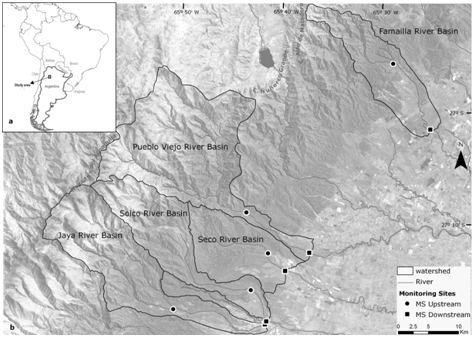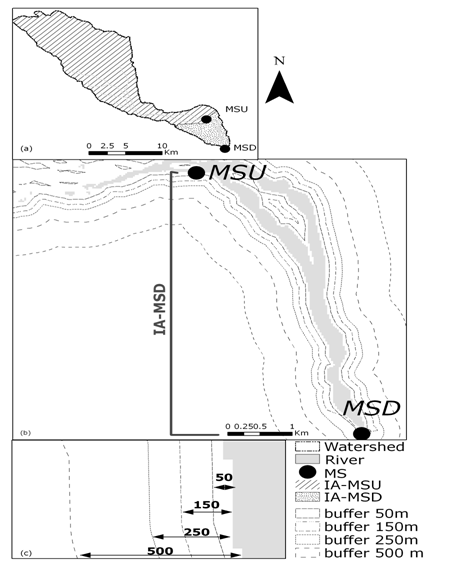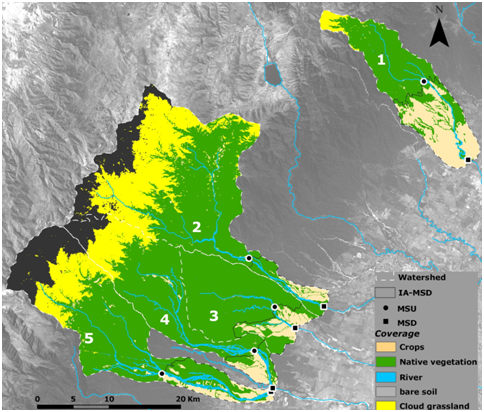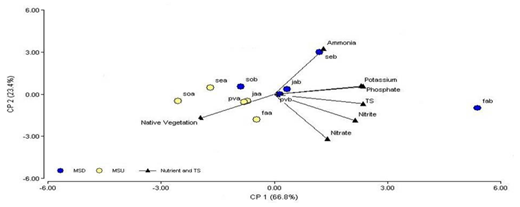eISSN: 2577-8307


Agriculture is the main source of surface and groundwater pollution. It increases suspended solids and organic matter concentration with the subsequent eutrophication. Citrus and sugarcane are the predominant crops in the subtropical area under study and the agrochemicals used in different periods of the year. This study was carried out taking into consideration main regional drivers as well as precipitation regime (seasonal rains) and ground conditions. Two monitoring sites were established: one that reflected conditions not affected by agricultural activities (upper watershed) and another affected by agricultural diffuse pollution (downstream) in the middle of the watershed. The Seco and Famaillá rivers show the effects of diffuse pollution caused by land use. There is a differential impact in river water quality that depends on the proportion of altered basins, riparian forest and kind of crop. Even though the measured physicochemical variables do not go beyond the established limits to be classified as contaminants, these monitoring stations are useful in the determination of water variations due to diffuse pollution. Evidences of riparian forests benefits mitigating effects of agricultural use of the soil were observed.
Keywords: citrus crops, sugarcane crops, organic matter, water quality, riparian forest
Water is a vital resource for human life; hence, maintaining water quality is essential to ensure the viability of the ecosystem services it provides .Agriculture is one of the main land uses that affect water resources, influencing supply and quality of both surface water and groundwater.1 The so-called non-point source pollution or diffuse pollution causes changes in dissolved oxygen, distribution and concentration of major ions, conductivity and pH.2,3 Diffuse pollution increases sediments and organic matter concentrations and provides pesticides.3,4 The amounts of nutrients (e.g. nitrogen and phosphorus compounds used in fertilizers) that can lead to eutrophication processes2,5 are also increased. Eutrophication involves processes that lead to poor water quality and low aquatic ecosystem diversity due to oxygen loss around the world.6
The province of Tucumán, situated in the Northwest of Argentina, is one of the chief lemon producers in the world and it is also an important sugar cane producer. The main agrochemicals associated with these crops are nitrogen, phosphorus, potassium, iron, zinc, boron, copper and molybdenum. Their use and application times vary according to the kind of crop. The most common are nitrogen, phosphorus, and potassium as they are fundamental at the time of production, but they are the principal causes of eutrophication in aquatic media.7 It is well known that native riparian vegetation works as buffer zones, reducing the nutrients that go into the water.8–11The buffer of riparian strip efficiency is determined by plant species composition, slope, width and precipitation regime among other factors (Gregory et al. 1991). Relationships between intensity, type of land use and buffering effect of the riparian strip on diffuse pollution is unknown in the Argentinean Northwes.12,13 The techniques and methods of landscape ecology with satellite images and the geographic information system help in the studies of buffer areas to reduce the harmful effects of current agricultural practices on river water quality.14,15 The aim of the present study is to determine the influence of agriculture on water quality in subtropical rivers by evaluating land use parameters and nutrient concentrations in river waters. We used the almost pristine mountain watersheds as reference areas. Our hypothesis is that subtropical crops alter the physicochemical characteristics of surface water.
Study area
The study was conducted in the province of Tucumán, northwestern Argentina. Five watersheds were selected: Jaya, Solco, Seco, Pueblo Viejo and Famailla Rivers (Figure 1). These watersheds have similar characteristics in terms of native vegetation, crop area, average discharge, geology and soils (Table 1).

Figure 1 a) Location of the study area in South America. b) Location of watersheds and monitoring sites in the study area.
Topographic units in the province include the plains area to the east and a mountain range to the west, with an approximate altitudinal range of 300 to 5000masl. Due to the presence of the mountain range, the climate is subtropical humid, with markedly seasonal orographic precipitations (1000/1500mm annually) and important contributions of fog during the dry season.16,17 The topographic characteristics and precipitation regimes result in an extensive west-southeast drainage network across the province. This hydrological system flows into the Salí-Dulce River, an endorheic watershed that extends through three provinces and comprises 89 936km2. Springs of Salí-Dulce River are located in the Nevados Del Aconquija mountain range (>4000masl) and drain an extensive area of mountain forest called Yungas. The Yungas (mountain rainforest) region is an area of varied topography, ranging from rainforest to misty pastures. Following the altitudinal gradient, the forest is classified as premontane lowland forest (400-700m), lower mountain forest (700-1500m) and upper temperate montane forest (1500-2500m).17 Two other ecosystems extend farther up the altitudinal zones: cloud grasslands and highland Andean grasslands).18 The premontane forest originally extended over a fertile subtropical plain that has been subjected to heavy anthropogenic activity and most of the native vegetation of the plain sector of the province has been replaced by crops and urban development.
Methodology
Two sampling Monitoring Sites (MS), MS upstream (MSU) and MS downstream (MSD), were established in each watershed (Figure 2). MSU sampling sites revealed conditions of the upper watershed and were used as reference sites (i.e. not affected by agricultural activities). They were characterized by native vegetation (lower mountain forest, upper temperate montane forest, and grasslands). MSD sampling sites were located in the middle of each watershed and exposed the effect of land use, the only non-point source of pollution in the area between the upstream and downstream stations; there are no urban or industrial developments in the area (Figure 3). This sector of the watersheds was originally characterized by premontane lowland forest and lower mountain forest vegetation. Elevation went from 480 to 810masl in MSU and from 380 to 450masl in MSD.

Figure 2 Schematized map of different landscape scales considered in this study. a) Watersheds and subdivisions and their influence areas in Monitoring Sites (IA-MS). b) Detail of the watershed sector considered as IA-MSD. c) Example of a detail of some riparian strips.
Analysis of land-cover types
The analysis of land-cover types was made with 2008 images, Landsat 5 TM (Thematic Mapper 231-79, spatial resolution of 30m) and China-Brazil Earth Resources Satellite program (CBERS 2B HRC 173: of the orbit 130E and 130B, points 2 to 5; orbit 130 C points 2, 3 and 5; orbit 130D, points 2 to 5, panchromatic images of 2.5m spatial resolution), provided by the National Institute of Space Research of Brazil (http://www.dgi.inpe.br/CDSR). We also used the Digital Elevation Model (DEM) from the shuttle radar topography mission (htpp://SRTM.CSI.CGIAR.ORG). The images were georeferenced to Gauss-Krügger (POSGAR 94) Zone 3 and geometrically corrected with GPS field points. Landsat 5TM images were atmospherically corrected using the method of Dark Object Subtractions (Chaves, 1996; Song et al., 2001); this modification consists of the conversion of the Digital Number (value between 0 and 255 recorded by the satellite sensor) to radiance and reflectance (0 to 1). Maps were generated using a supervised classification; training areas were identified by means of Landsat and CBERS 2B HRC images. Digital classification was done using 13 bands: bands 1-5 and 7 of Landsat image (band 6 was discarded because it has a different resolution that corresponds to a thermal band); three bands obtained after processing DEM (elevation, slope and its exposure); three bands obtained from the procedure “Tasseled Cap” (brightness, greenness and wetness); and a band from the Normalized Vegetation Index (NDVI).
Classification was carried out with the Random Forest (RF) algorithm developed by19 with classification task of the R package.20 Random Forest algorithm has been identified as a suitable method for ecological studies.21–23 Four categories were defined for classification: preserved forest, highland grassland, bare soil and cropland. For the map, we used a filter with a 3 x 3-pixel window. Accuracy of maps was evaluated using a confusion matrix, employing a 1000x1000m grid.
With the map obtained, vegetation cover was estimated for each sampling site; each watershed was divided into two sectors using the elevation contour obtained from DEM and by visual interpretation in vector format with CBERS images using Arc Gis 9.2. The analysis of each watershed considered (Figure 2) an upper site (area of influence of the upstream monitoring site: AI-MSU) and a lower site (area between the upstream and downstream sites: AI-MSD). Visual interpretation was carried out to improve accuracy in the AI-MSD digitalization in vectorial format and to determine which crops were dominant in each watershed. Using satellite images, we determined different crop types (mostly sugar cane and lemon fruit), the proportion of native forest vs agricultural area, slope, and dominant cover types for riparian strips of different widths. To determine the impacts in water quality we analyzed nutrient concentration in five rivers with similar agricultural matrix, comparing them with reference sites. The proportion of native vegetation and crops, types of crops and the slope of cultivated land were determined with the cover map. In addition, riparian strips of different width categories: 50, 100, 150, 200, 250, 500, 1000, and >1000m were calculated considering the river bed (bankfull width) as level zero (IA-MSD area in Figure 2). Finally, the proportion of vegetation cover and the slope in the riparian strip areas were estimated.
Physical and chemical analyses
We took water samples for physical and chemical analyses every two months in 2009 and 2010 (11 total sample dates); stations were also sampled. Samples of surface water were taken with white high density propylene bottles (1liter) and stored without air bubbles. We also prepared blank samples for each survey, consisting of distilled water bottled in the field. All samples were collected, handled and preserved at the same time and in the same way. All samples were processed following standardized protocols of.24–26 Presence of any parameters in the field blank samples could indicate contamination during the sampling process or from sampling equipment and supplies. Deviation in parameters of the duplicate water samples could indicate contamination or incorrect sample processing.
Field measurements were carried out for dissolved oxygen with a Hach Senlon6 oximeter, conductivity with a pocket meter Hach SenIon 156, pH using a Metrohm 826 Mobile, and total alkalinity with a colorimetric method. In the laboratory of Facultad de Ciencias Naturales & “Miguel Lillo” Institute, Universidad National de Tucumán, we determined the following parameters: total solids, major ion composition (calcium, magnesium, sodium, chloride, sulfate, and bicarbonate) and nutrients (ammonia, nitrite, nitrate, phosphate and potassium) with error <5%. Bicarbonate was calculated using neutralization volumetry while major ion composition, nitrite and nitrate were established with ionic chromatography (Metrohm IC881) at constant temperature (25 ºC). Ammonium was detected using the Nessler method and Phosphate was confirmed with the ascorbic acid method.
Statistical analyses
The influence of the environmental variables measured was analyzed by means of the Principal Component Analysis (PCA) with 11 samples from MSU and MSD of each river, including percentage of native riparian vegetation cover for each riparian strip, nutrients (ammonia, nitrite, nitrate, phosphate, and potassium) and total solids. To establish differences between reference areas (IA-MSU) and crop areas (IA-MSD) we compared MS of each river (intra-watershed comparison) with a paired t test analyzing variables associated with diffuse pollution (nutrients and total solids). To establish different degrees of land use, an inter-watershed comparison was carried out using an analysis of variance (ANOVA) of the diffuse pollution variables. It was done with a new variable calculated from concentration mean differences of each MS to test variance homogeneity.
River water in the five watersheds was characterized as calcic bicarbonated, well oxigenated and with low total solids concentration. Conductivity revealed a slight salinization and nutrients concentration at each site during the study (Table 1). Watershed areas above the IA-MSU (Figure 2) were covered by native vegetation. By contrast, areas above the IA-MSD were covered by a mean of 68% native vegetation and 32% crops (Figure 3 & Table 1). Details about cultivated areas of IA-MSD are presented in Table 1. The comparison of the major density of the cultivated area (>40%) in IA-MSD revealed that the highest dense areas in the riparian strips was in Famaillá River. Note for this river an area of 40% cultivated in 150m of the riparian strip (Table 1). Main crop distributions (sugar cane and citric fruits) are shown in Table 2. Note that citrus fruits are predominant in Solco and Pueblo Viejo Rivers, while sugar cane prevails in Jaya River. On the other hand, Seco and Famaillá Rivers have an even crop distribution (Table 2). The multivariate analysis accounted for 90% of the total variability for the first two axes. The upstream sites were located on the left of axis 1 of the PCA plot, whereas all, except one of the downstream sites, were on the right side (Figure 4). Axis 1 was characterized by phosphates (r2=0.95), potassium (r2=0.93), nitrites (r2=0.90), TS (r2=0.97) and native vegetation (r2=0.94). In contrast, ammonium concentration of the second axis separates Seco River MSD from MSU (Figure 4). It is noted in Table 1 that nutrients were always higher in IA-MSD than MSU. T test analysis showed differences among diffuse pollution variables (Table 3). Famaillá River presented differences between MS in five variables (NO2-, NH4+, TS, K+ y PO43-). Seco and Pueblo Viejo Rivers were unlike in two variables (K+ y PO43-) while Solco differed in (TS y NH4+) (Table 3). Jaya River was dissimilar in only one variable (K+) (p<0.007). ANOVA showed significant differences among rivers in potassium, phosphate and total solids (Table 4). Tukey test showed differences between Famaillá and all other rivers in potassium and total solids. Phosphate was significantly different in Famaillá when compared to Jaya and Seco Rivers. Anova does not revealed nitrogenous nutrients differences; they were similar in the studied rivers (Table 1) (Table 4). Significant differences were observed between dry and rainy periods for some ions as well as bicarbonate (p<0.0001), calcium (p=0.0001), magnesium (p=0.0021) and sodium (p=0.0083).
IA-MSD |
Sugar Cane |
Citric Fruits |
Othera |
Solco |
4 |
46 |
0 |
Seco |
24 |
20 |
1 |
Pueblo Viejo |
5 |
21 |
4 |
Jaya |
16 |
4 |
13 |
Famailla |
26 |
28 |
14 |
Table 2 Types of crop in percentage of each IA-MSD.
a: Blueberry, Forestry, Potato, etc.

Figure 3 Land cover in the watersheds. Detail of cover type observed in the watersheds of 1 Famaillá River, 2 Pueblo Viejo River, 3 Seco River, 4 Solco River, 5 Jaya River.

Figure 4 Principal component analysis-ordination triplot showing sampled sites and supplementary environmental variables as arrows. Highest nutrient concentration is observed in monitoring site downstream of Famaillá (fab) and Seco (seb) Rivers.
Famailla |
Jaya |
Pueblo Viejo |
Seco |
Solco |
||||||
p |
t |
p |
t |
p |
t |
p |
t |
p |
t |
|
K+ |
0 |
-6.57 |
0.007 |
-3.625 |
0.059 |
-2.195 |
0.012 |
-3.249 |
0.379 |
-0.949 |
NO2− |
0.052 |
-2.275 |
0.853 |
0.191 |
0.187 |
-1.443 |
0.103 |
-1.843 |
0.109 |
-1.879 |
NO3− |
0.714 |
-0.379 |
0.828 |
-0.225 |
0.147 |
1.604 |
0.892 |
-0.14 |
0.64 |
0.493 |
NH4+ |
0 |
-6.389 |
0.349 |
-0.994 |
0.84 |
-0.208 |
0.361 |
-0.98 |
0.035 |
-2.714 |
PO43− |
0 |
-7.63 |
0.521 |
-0.672 |
0.051 |
-2.298 |
0.023 |
-2.799 |
0.136 |
-1.724 |
TS |
0.004 |
-4.069 |
0.934 |
0.085 |
0.846 |
0.201 |
0.233 |
0.233 |
0.006 |
-4.171 |
Table 3 Paired t test for each river comparing MS and using nutrients and Total Suspended Solids (p <0.05)
Test of Homogeneity of Variance |
|||
p |
F |
p |
|
K+ |
0.000* |
7.011 |
0.527 |
NO2− |
0.082 |
2.245 |
0.042 |
NO3− |
0.856 |
0.330 |
0.000 |
NH4+ |
0.652 |
0.618 |
0.608 |
PO43− |
0.010** |
3.858 |
0.608 |
TS |
0.000*** |
6.737 |
0.063 |
Table 4 Difference in nutrient content between rivers.
p values from one-way Anova; *, ** and ***multiple comparisons with K+, PO43-, TS
Multiple comparisons (HSD of Tukey) |
||
K+ (*) |
||
River I |
River II |
p |
Famaillá |
Jaya |
0.001 |
Pueblo Viejo |
0.001 |
|
Seco |
0.035 |
|
Solco |
0.001 |
|
PO43−(**) |
||
River I |
River II |
p |
Famaillá |
Jaya |
0.009 |
Pueblo Viejo |
0.057 |
|
Seco |
0.044 |
|
Solco |
0.067 |
TS (***) |
||
River I |
River II |
p |
Famaillá |
Jaya |
0.001 |
Pueblo Viejo |
0.001 |
|
Seco |
0.008 |
|
Solco |
0.046 |
Our study confirmed that the presence of crops alters the physicochemical characteristics of water in watersheds with geographical features not considered before. However, crop type and intensity (quantity and riparian vegetation) alter surface water in different ways as observed.15 The difference in potassium, nitrite, ammonia, phosphate and total solids concentrations observed between upstream and downstream stations of Famaillá Rivers was likely a consequence of the intense IA-MSD land use. The IA-MSD of Famaillá River presented the highest land use intensity, covering more than 60% of the area. The highest riparian strip land use observed in this river show the riparian zones effects, reducing nutrients entry. These results are consistent with other studies that have demonstrated the importance of native vegetation as a filter for nutrients and fine sediments.27,28,4,14 According to,29 native vegetation reduces the impact of crops on water quality; its efficiency varies depending on riparian strip width which ranged from 10 to 100 m. The comparison of the density of the cultivated area in IA-MSD among Famaillá, Seco and Solco Rivers (69%, 49% and 45% respectively) revealed that the less dense areas in the riparian strips of Seco and Solco Rivers were maximizing the potential reduction of nutrients and solids in water. These two watersheds presented a less dense cultivated area in the 150m riparian strip. Famaillá River presented higher intensity of land use in the riparian strip (40% in the 0-150m) affecting the filter capacity of the buffer strip.30
Although the watersheds were relatively close (Figure 1) the suite of nutrients in the river waters was not similar probably due to the different fertilizers used on the crops (sugar cane and citric fruit). For example, Famaillá, Pueblo Viejo and Solco Rivers had similar phosphate concentrations because their citric plantation was >21% vs Jaya River with <4% .On the other hand, although the citrus area in Seco River was 20%, nutrient concentration differed from that of other rivers, probably because the citrus plantation included sour orange. The higher ammonium concentrations in Seco River AI-MSD may be related to the specific type of citric (sour orange). Nutrients quantities in studied rivers are not important at the present but some measures must be taken for government agencies such as sanctions and other also using natural mitigation process.15 In Tucuman, many anthropogenic activities such as cultivation in riparian areas and logging are forbidden by law in terrain with slopes above 10%, because they are considered unsuitable practices with respect to soil conservation. In the watersheds studied, cultivated lands were characterized by a very modest slope (<5%), while only 0.02% of the land cover was above that value (Famaillá and Jaya watersheds). The need to consider landscape characteristics such as slope in relation to water quality was reported by,31 who indicated that pollutant runoff from crop areas increased with increasing slope. In another river of Tucumán (Lules River watershed), with comparable elevation and environmental conditions, crops are cultivated in riparian areas and more than 50% are grown on lands with 10% slope.17,11 However, nutrient concentrations were always lower than those measured in the present study.32 This may be explained by less intensive practices in small crop fields by settled farmers in the Lules River watershed,33,11 compared with the more industrial agricultural practices in the five watersheds treated here. We attributed the differences observed to the more intensive use of manure in the industrial agricultural practices. However, only one of the five watersheds studied, with intensive land use, showed significant differences in five out of six variables measured (NO2-, NO3-NH4+, TS, K+ y PO43-). This difference can be attributed to the more intense use of the riparian strip in Famaillá River (Table 1). The findings in this work agree with the many other authors who noticed that riparian forests may mitigate the effects of agricultural and urban use of the soil.34,35
These results support those of other studies that concluded that riparian vegetation retains high yields of phosphorus and sediment.36,37,15 However,13 noted in some Tucuman Rivers that flow is a more relevant factor influencing Total Solids concentrations than riparian forests quality. These findings have important implications for ecosystem management policies.29 The fact that our watersheds do not evidence high pollution values facilitates the identification of preventive measures that would avoid irreversible environmental damage like that observed in the plains.38 River water showed physical and chemical characteristics typical of subtropical rivers in the transition flow from a mountain area to a lowland area in spite of intensive soil use in the basins studied. Significant differences observed between dry and rainy periods for some ions are not remarkable being and attributable to rock dilution process. No dragging process for nutrients was observable during rainy periods. However we need to take particular attention monsoonal rainy climate as a main driver for biogeochemical processes in this region.39 This study introduces these watersheds as touchstone because they provide information on how the riparian ecosystem works to improve water quality in this area. Integration, management and planning of hydric resources are the principles of water sustainability. Thus, management based on the sophisticated combination of social sciences and ecology would furnish sustainable solutions to the scarcity and degradation of hydric ecosystems.38–46
Basin size, area of agricultural use, type of crop, land slope, and riparian vegetation are extremely important because they influence the physicochemical quality of surface water. Thus, they should be taken into account if we are to minimize the effect of diffuse pollution in the rivers. Although the rivers studied here did not show important signals of degradation, these data are extremely important as they reflect pristine conditions or the first stages of diffuse pollution. We observed when buffer strip between 0-150m is affected for land use (>40%) shows a diminished filter capacity. Different fertilizers used in subtropical crops affect river water differently but phosphorous must be tracked. Hence, identification of management criteria will help minimize hydric resource degradation in the plains and mitigate the effect of agricultural expansion in mountain areas of steeper slopes.
This study was funded by CONICET (through doctorate fellowships type I and II) and the Projects: PICT_01-12529, CIUNT G213, and CIUNT 26/G309.
We thank C. Molineri, P. Blendiger, L.A. Fernandez, A. Malizia, and A. Izquierdo for comments that improved this manuscript. We are very grateful to J. Blake and B. Reid for manuscript comments and language improvement. We are also grateful to K. Gómez Rojas, P. Powel, R. Moreno, J. Giordano, P. Albornoz Medina, A. Gioia, C. Molineri, G. Aguilera and G. Padilla Bortayro for field assistance.
Authors declare that there is no conflict of interest.

© . This is an open access article distributed under the terms of the, which permits unrestricted use, distribution, and build upon your work non-commercially.